Let's cut straight to the chase. Shiraz is the bold, full-bodied red bursting with spicy, dark fruit flavours. Merlot, on the other hand, is the softer, medium-bodied red celebrated for its smooth texture and plush red fruit notes.
Your choice between the two often boils down to a simple question: are you in the mood for a powerful, peppery wine or something more smooth and fruit-forward?
A Quick Comparison of Shiraz vs Merlot
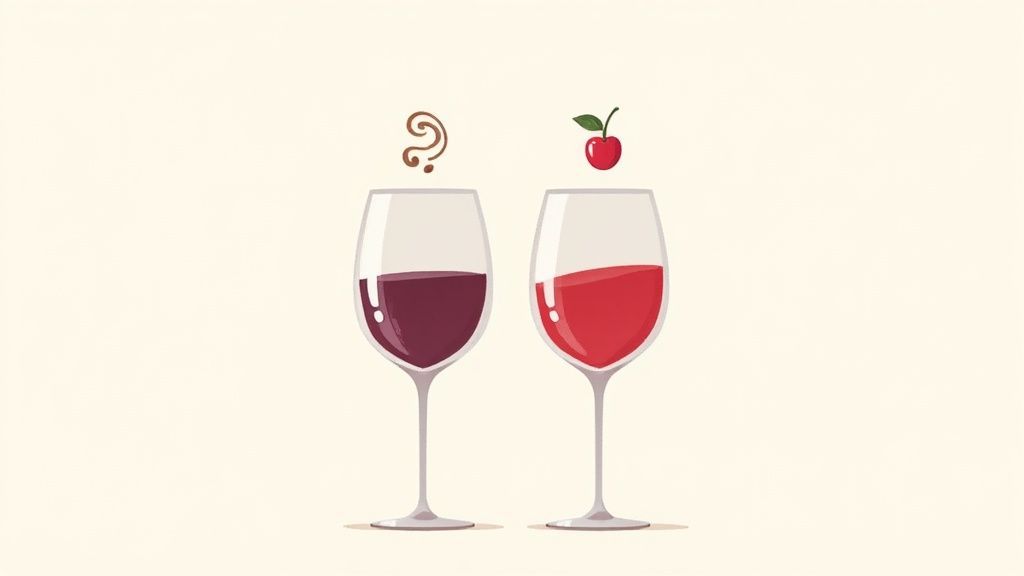
Before we get into the nitty-gritty, it helps to have a clear picture of each wine's core personality.
Think of Shiraz as the confident, robust sibling. It walks into a room and makes a statement with its deep colour, rich palate, and peppery finish. This is the wine you bring to a barbecue or pair with a hearty, flavour-packed meal.
Merlot is the approachable, versatile one. Its soft, velvety texture and easy-drinking nature make it a crowd-pleaser at social gatherings or a perfect companion for a quiet weeknight dinner. The flavours are typically gentler, centring around ripe red fruits like cherry and plum.
Key Takeaway: Shiraz brings the power and spice, making it a hit with drinkers who love intensity. Merlot offers softness and approachability, perfect for those who value smoothness and elegance in their red wine.
This fundamental difference in character really guides everything else in the Shiraz vs Merlot debate, from food pairings to how it tastes from different regions. To make it even clearer, let's break them down side-by-side.
Shiraz vs Merlot At a Glance
This table offers a direct comparison of the key traits that define each wine. It’s a handy cheat sheet to help you quickly figure out which one best suits your taste and the occasion.
| Characteristic | Shiraz | Merlot |
|---|---|---|
| Primary Flavours | Blackberry, plum, black pepper, spice | Cherry, plum, raspberry, vanilla, mocha |
| Body | Medium to Full-bodied | Medium-bodied |
| Tannins | High and firm | Medium and soft |
| Acidity | Medium to High | Medium |
| Key AU Regions | Barossa Valley, McLaren Vale, Hunter Valley | Riverland, Langhorne Creek, Coonawarra |
| Food Pairing | Barbecued meats, rich stews, aged cheese | Roast chicken, pork, mushroom dishes |
At a glance, you can see how the firm tannins and bold flavours of Shiraz make it a natural match for rich foods, while Merlot’s softer profile makes it a more flexible partner for a wider range of dishes.
Understanding Shiraz: Australia’s Signature Red
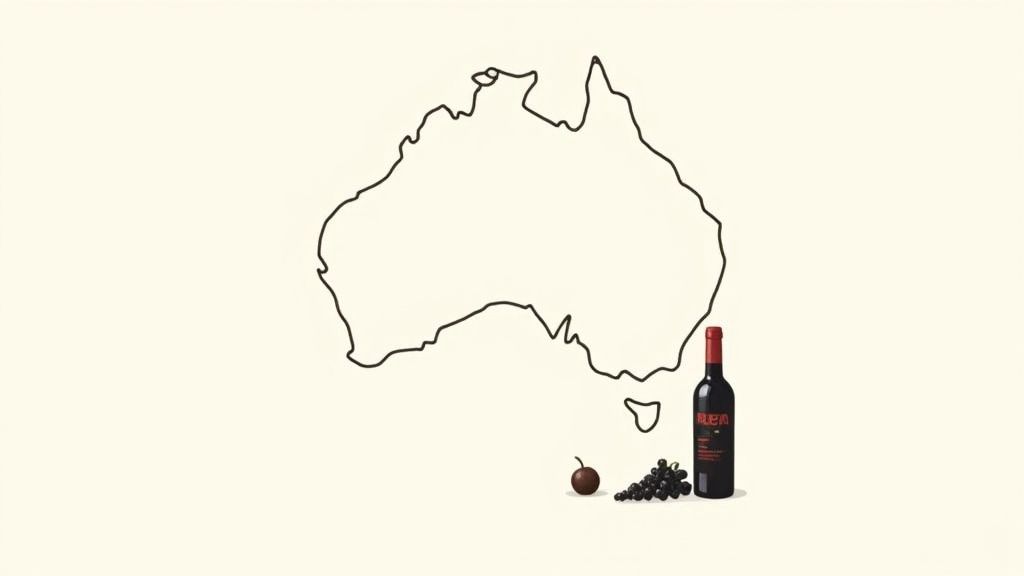
If you had to pick one wine that defines Australia, it would almost certainly be Shiraz. It’s far more than just another popular grape; it's a true icon, woven into the very fabric of our winemaking identity. Its story, from historic vines planted back in the mid-1800s to its current status as a global powerhouse, is one of incredible resilience and perfect adaptation.
Shiraz has simply found its ideal home in Australia's diverse climates, producing wines that are unapologetically bold and brimming with character. This isn't just a feeling the numbers back it up. Over the 15 years leading up to 2023, Australia’s Shiraz grape crush averaged around 417,000 tonnes a year, hitting a massive peak of 535,000 tonnes in 2021.
Because it's planted so widely, you get this incredible spectrum of styles, each one telling the story of the unique patch of dirt where it was grown.
The Classic Flavour Profile
At its heart, Australian Shiraz is a full-sensory experience. The flavour is typically built on a foundation of rich, dark fruits that feel generous and inviting.
- Primary Fruit Notes: Think intense blackberry, dark plum, and black cherry. These flavours are often ripe and luscious, sometimes leaning into jammy territory, which gives the wine a wonderful mouthfeel.
- Signature Spice: The real hallmark of a great Aussie Shiraz is its distinctive peppery kick. You'll often find notes of black pepper, clove, and a touch of anise, which add a savoury complexity that makes it so compelling.
- Secondary Layers: With a bit of time, especially in oak barrels, deeper notes of dark chocolate, liquorice, and vanilla start to emerge. These add layers of richness and depth that round out the wine beautifully.
It’s this marriage of bold fruit and savoury spice that makes the Shiraz vs Merlot comparison so fascinating. Where Merlot is often soft and rounded, Shiraz is structured, assertive, and full of personality.
For many wine lovers, Australian Shiraz is the definitive modern, fruit-forward red. It’s a grape that isn’t afraid to be loud, offering a full-bodied profile with firm tannins that give it excellent structure and the potential to age gracefully.
How Climate Shapes The Wine
The true genius of Shiraz is its ability to be a chameleon, perfectly reflecting its environment. The very same grape can produce dramatically different wines depending on where it’s grown.
Take a warm-climate Shiraz from a region like the Barossa Valley. It’s going to be big, bold, and opulent. All that sunshine ripens the grapes to perfection, resulting in higher alcohol and concentrated flavours of blackberry jam, mocha, and sweet spice. For a deeper dive, check out our complete guide to McLaren Vale Shiraz, another warm region known for producing powerful, world-class expressions.
On the other hand, a cool-climate Shiraz from the Adelaide Hills or Victoria’s Grampians region offers something completely different a more restrained and elegant style. These wines are typically more medium-bodied with higher acidity, showcasing savoury notes of black pepper, herbs, and red fruits. They feel much closer in style to a classic French Syrah. This incredible versatility is precisely why Shiraz remains Australia's undisputed signature red.
Exploring Merlot: The Approachable Red
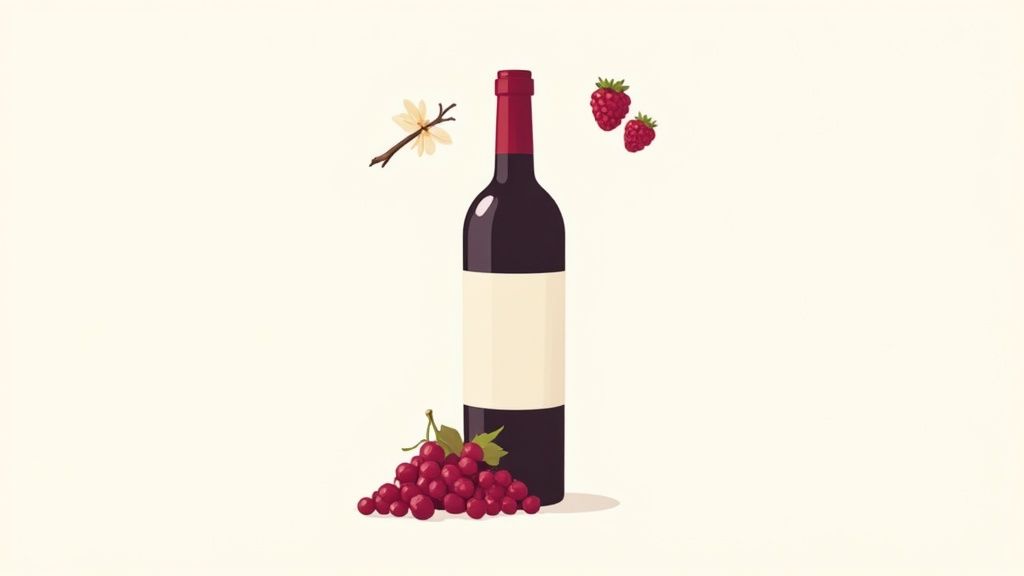
While Shiraz often grabs the spotlight as Australia's bold icon, Merlot plays a different, equally important role. It's the smooth, easy going, and incredibly versatile red that wins you over with its plush texture and gentle, fruit forward personality.
Think of Merlot as the softer counterpart in the Shiraz vs Merlot discussion. It's the kind of wine that doesn't scream for your attention but consistently rewards it with pure, easy-drinking pleasure. Its defining features are a smooth, medium body, soft tannins, and a velvety texture that feels welcoming from the very first sip. This immediate appeal makes Merlot a reliable crowd pleaser for any occasion.
A Profile of Softness and Fruit
At its heart, Merlot is all about ripe, red fruits. It swaps the dark, peppery intensity of a big Shiraz for a more gentle, welcoming fruitiness that's hard to resist.
- Primary Fruit Flavours: Expect a generous core of cherry, raspberry, and juicy plum to lead the way.
- Subtle Undertones: Behind the fruit, you'll often find delicate hints of vanilla, mocha, and sometimes a touch of cedar or herbs.
- Velvety Texture: Its famously soft tannins are the key to its popularity, creating a round, smooth mouthfeel that glides across the palate.
This delicious combination makes Merlot incredibly food friendly and a fantastic starting point for anyone new to red wine. To get a better sense of its classic European roots, you can explore the origins of the Merlot wine grape.
Merlot’s reputation was famously (and unfairly) tarnished by a single line in the 2004 film Sideways. This "Sideways effect" saw sales dip as drinkers suddenly sought out more "serious" wines. Yet, its enduring appeal proves that well-made Merlot is timeless, offering a drinking experience that is both comforting and genuinely elegant.
Merlot in the Australian Market
Here in Australia, Merlot has carved out a niche as a consistent, value-driven choice. It absolutely thrives in warmer inland regions like the Riverland and Langhorne Creek, which reliably produce that soft, fruit forward style Australian Merlot is known for.
While it's a significant grape, it occupies a much smaller footprint than Shiraz. Merlot covers roughly 8,480 hectares, which is about 6.3 percent of Australia’s total wine grape area. Its market position is solidly focused on creating accessible wines meant for immediate enjoyment.
In 2016, exports totalled 53 million litres, with the vast majority priced in the very approachable $2.50 to $4.99 AUD per litre bracket. This focus on accessibility has cemented its place as a staple for casual dinners and social get-togethers.
Deconstructing Flavour, Body and Structure
Once you get past the label, the real difference between Shiraz and Merlot comes alive in the glass. While both are fantastic red wines, they speak in completely different languages. Learning to recognise their distinct flavour profiles, body, and structure is the secret to figuring out which one you’ll enjoy more.
Shiraz makes its presence known immediately. That first sip usually hits you with a powerful wave of dark fruit think blackberry, black plum, and even rich, dark cherry. These flavours are anything but subtle; they’re concentrated and can feel almost jammy, especially in warmer Aussie climates like ours. But what really defines Shiraz is its trademark spicy, savoury kick. You can almost always count on a distinct note of black pepper, sometimes with friends like cloves, anise, or a smoky, bacony richness.
Merlot, on the other hand, is a much softer introduction. Its fruit tends to be redder ripe cherry, raspberry, and pillowy soft plum. Instead of that peppery spice, Merlot’s other notes are gentler, hinting at things like vanilla, mocha, or cedar, with the occasional subtle herbal touch. It’s a wine built on plushness, not sheer power.
Understanding Body and Texture
The term "body" in wine is all about how it feels in your mouth its weight, its viscosity. This is where you can physically feel the difference between Shiraz and Merlot.
Shiraz is undeniably a full-bodied wine. It feels dense and substantial on the palate, coating your mouth with its intensity. This weight comes from higher alcohol and more extraction from the grape skins during the winemaking process.
Merlot is typically medium-bodied. It feels lighter, smoother, with a texture that's often described as velvety or silky. That roundness is thanks to its softer tannins and slightly lower alcohol, creating a wine that feels less demanding and more approachable right from the get-go. If you want to dive deeper into this, our complete guide to wine weight and texture is a great read.
Key Difference: Think about the textural difference between full-cream milk and a lighter milk. Shiraz has that rich, mouth-coating weight of full-cream, whereas Merlot has a smoother, less dense consistency. This tactile difference is a huge part of what makes each wine special.
Structure, Tannins and Finish
Finally, let's talk about structure. This is mostly about tannins the natural compounds from grape skins that create a drying sensation in your mouth, a bit like a strong cup of black tea. They give a wine its backbone and are crucial for its ability to age well.
Shiraz is known for its firm, grippy tannins. They build a powerful frame that holds up all those intense fruit flavours, leading to a long, structured finish. It’s these tannins that allow a top-quality Shiraz to soften and evolve beautifully in the cellar for years.
Merlot’s tannins are famously soft and fine-grained. They add to its velvety texture without being overly astringent, making the wine feel smooth and easy-drinking even when it's young. This is a big reason why Merlot is often seen as the more "approachable" of the two right after release.
Let's break down how these two stack up side-by-side.
Sensory Profile Breakdown
This table gives a snapshot of the typical sensory experience you can expect from a classic Shiraz versus a classic Merlot. Of course, winemaking style and region play a huge role, but this is a great starting point for understanding their core personalities.
| Sensory Element | Shiraz (Typical Profile) | Merlot (Typical Profile) |
|---|---|---|
| Aromas | Blackberry, plum, black pepper, clove, smoke, liquorice | Cherry, raspberry, plum, vanilla, mocha, cedar, bay leaf |
| Flavours | Bold dark fruits, savoury notes (olive, bacon), pronounced spice | Soft red fruits, hints of chocolate, subtle herbal notes, gentle oak |
| Body | Full-bodied; feels weighty and dense in the mouth | Medium-bodied; feels smooth and rounded |
| Tannins | Firm and grippy; provides a strong structural backbone | Soft and velvety; fine-grained, creating a plush texture |
| Acidity | Moderate to high; keeps the bold fruit in check | Moderate; enough to provide freshness without being sharp |
| Finish | Long and persistent, often with lingering spice | Smooth and soft, typically shorter than Shiraz but very pleasant |
Ultimately, this structural and textural contrast is a critical factor when choosing between Shiraz and Merlot. It shapes not just how the wine feels in your mouth, but how it pairs with food and its potential to get even better with age.
Matching Food With Shiraz And Merlot
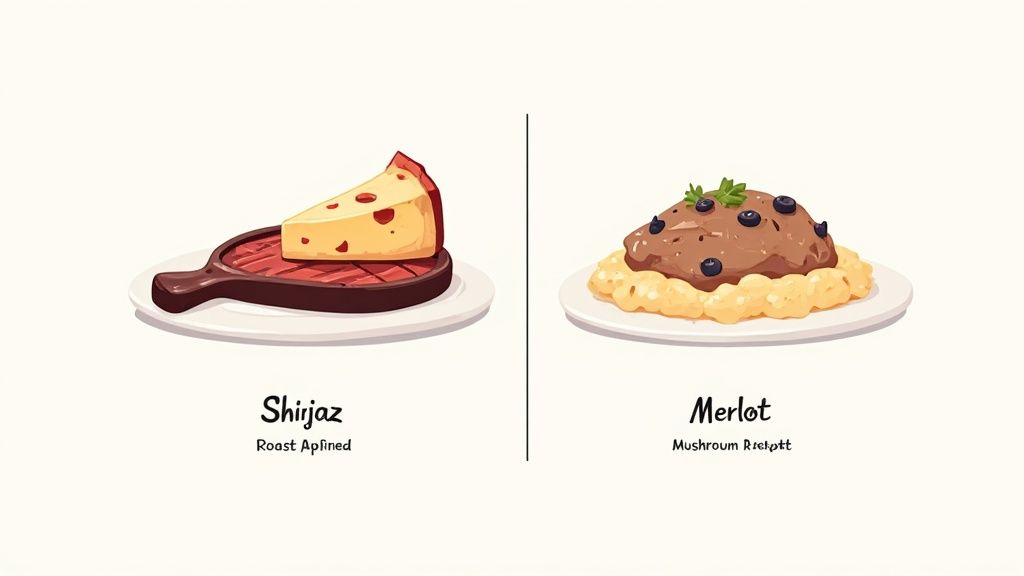
Half the fun of opening a bottle is deciding what’s on the dinner plate. Choosing between Shiraz and Merlot often comes down to this very question. A great food and wine pairing elevates everything, turning a simple meal into something truly memorable. The trick is to match the weight and intensity of your dish with the character of the wine.
Shiraz, with its big personality and firm tannins, calls for food that can hold its own. This is a wine that loves rich, savoury, and even spicy dishes. Merlot, on the other hand, is softer and more fruit-forward, making it a brilliant and versatile partner for a much wider range of meals, where it complements flavours rather than competing with them.
Perfect Pairings For Bold Shiraz
When you think Shiraz, think rich, robust, and flavourful. The secret lies in its high tannins, which act as a fantastic palate cleanser by cutting straight through fat. This quality makes it a no-brainer for hearty meat dishes.
- Barbecued Meats: A classic Aussie barbecue is Shiraz territory. The wine’s smoky, peppery notes are a perfect match for grilled steak, lamb chops, or saucy ribs.
- Hearty Stews and Casseroles: A slow-cooked beef and mushroom pie or a rich lamb shank stew finds its soulmate in a full-bodied Shiraz.
- Aged Cheeses: Hard, aged cheeses like a sharp cheddar or a punchy pecorino have the intensity needed to stand up to Shiraz's powerful structure.
It's a beautiful bit of food science: the protein and fat in rich meats soften the wine's tannins, making it feel smoother on the palate. In return, the wine’s spicy notes amplify the savoury flavours in the food. It's a perfect symbiotic relationship.
Versatile Food Matches For Smooth Merlot
Merlot's approachable, easy-going nature makes it one of the most food-friendly reds you can find. Its softer tannins and plush red fruit profile mean it won't steamroll more delicate dishes.
For those dining out or seeking new recipes, finding the best food review app can be a game-changer for discovering dishes that will pair wonderfully with your chosen wine.
- Roast Chicken or Pork Loin: Merlot has a knack for enhancing the subtle flavours of white meats, especially when they're cooked with a herb-based marinade.
- Mushroom Risotto: The earthy, umami character of mushrooms is a brilliant stage for Merlot's soft fruit and subtle vanilla notes to shine.
- Pasta with Tomato-Based Sauces: Think spaghetti bolognese or a simple arrabbiata. Merlot's moderate acidity and fruitiness harmonise beautifully with the tomatoes.
The Bridge Pairing: A Gourmet Burger
Sometimes, a single dish can swing both ways, and the gourmet burger is a perfect example. The choice between Shiraz vs Merlot here really comes down to the burger's build and your personal taste.
If you’re having a classic beef patty loaded with cheese and bacon, the bold structure of a Shiraz will cut through all that richness brilliantly. But if your burger features leaner meat, a mushroom patty, or more delicate toppings, the softer, fruitier profile of a Merlot will be a superb match, complementing the flavours gracefully without taking over.
How To Choose The Right Wine For Any Occasion
Trying to decide between a Shiraz and a Merlot? The real question isn’t about which wine is "better," but which one is better for right now. The perfect bottle depends entirely on the occasion, the food, the company, and even your mood.
Think of it like choosing a soundtrack for a moment. By matching the wine’s personality to the atmosphere of the event, you can stop staring at the labels and start pouring the perfect glass every time.
When To Reach For Shiraz
Shiraz is the wine you choose when you want to make a statement. Its bold, complex character and intense flavours are made for moments that are equally rich and memorable.
Pull out a Shiraz for:
- A Classic Backyard Barbecue: Nothing stands up to smoky, grilled meats and tangy sauces better than the peppery, robust notes of a good Shiraz. It’s a natural fit.
- A Cosy Winter Evening: When it's cold outside, the full body and warming spice of Shiraz feel like the ultimate comfort in a glass.
- Impressing a Wine Lover: If you want to show someone you know your stuff, a high-quality Australian Shiraz is a fantastic choice. Its depth and ability to age beautifully are things true enthusiasts really appreciate.
When Merlot Is The Perfect Choice
Merlot’s greatest strength is its smooth, approachable charm. It’s the ultimate crowd-pleaser, with soft tannins and a fruity profile that make it incredibly versatile and a safe bet for almost any social gathering.
Opt for Merlot when:
- Hosting a Large Gathering: It’s a wine that everyone can enjoy, from those new to reds to seasoned drinkers. It won’t overpower anyone’s palate.
- A Casual Weeknight Dinner: Its easy-drinking style is perfect for simple meals like pasta or a roast chicken, where you want a wine that complements the food without stealing the show.
- You Need a Reliable Crowd-Pleaser: For parties or events with a wide variety of food, Merlot is the elegant, go-to choice that just works.
It’s also interesting to see how market trends can influence what’s on the shelves. For example, recent Australian figures show Chardonnay has actually overtaken Shiraz in production. At the same time, exports of value-priced Merlot have dropped off, suggesting a broader shift towards more premium wines. You can dive deeper into these market shifts and what they mean for your wine choices.
A Few Final Questions
Even after a deep dive, there are always a few lingering questions when it comes to picking between Shiraz and Merlot. Getting a straight answer can be the final piece of the puzzle.
Let’s clear up some of the most common queries.
Which is Sweeter, Shiraz or Merlot?
Technically, neither. Both Shiraz and Merlot are made as dry red wines, meaning the grape sugars have been converted to alcohol.
But what you're probably asking is which one tastes sweeter. That would be Merlot. Its profile is loaded with ripe red fruit flavours like cherry and plum, and it has a much softer, plusher texture on the palate. With fewer sharp tannins or aggressive spices, that pure fruitiness really comes forward, giving the impression of sweetness.
Shiraz, on the other hand, usually brings a more savoury game with its bold spice, black pepper, and firmer structure. It’s less about overt fruitiness and more about power and complexity.
Is Shiraz a Good Wine for Beginners?
Many will point you to Merlot as the perfect beginner's wine, and they're not wrong. Its smooth texture and friendly fruit flavours make it incredibly easy to like. It’s a very safe first step.
However, a big, fruit-forward Australian Shiraz can be just as good for a newcomer. Its flavours of blackberry, pepper, and sometimes a hint of chocolate are so bold and obvious that they’re easy for a new palate to pick out and remember. It might be a little full-on at first, but you’ll know exactly what you’re tasting.
The best wine for a beginner is one that clearly expresses its character. Both Shiraz and Merlot do this brilliantly, just in different ways one with power, the other with softness. It really just depends on whether you prefer bold flavours or a gentler introduction.
Can You Age Both Shiraz and Merlot?
Yes, but this is where they really part ways. A high quality Shiraz, especially from top-tier Aussie regions like the Barossa Valley or our own McLaren Vale, is built for the cellar. Over a few years (or even decades), its powerful tannins will soften beautifully, and incredible savoury notes of leather, earth, and smoked meat will emerge.
While a few exceptional, top-shelf Merlots can age gracefully, the vast majority are made to be enjoyed right now. They simply don’t have the structure to improve much with time. If you’re looking to buy a wine to lay down, a well-made Shiraz is almost always the more reliable bet.
Ready to explore the bold, rich flavours of McLaren Vale? At McLaren Vale Cellars, we specialise in premium Shiraz and other regional favourites. Discover your next perfect bottle today.

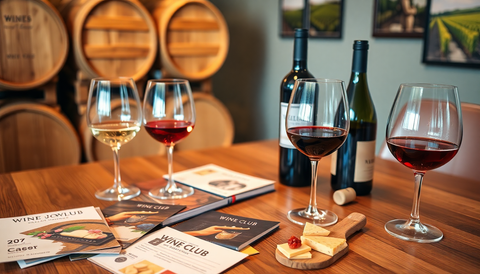


Comments (0)
There are no comments for this article. Be the first one to leave a message!